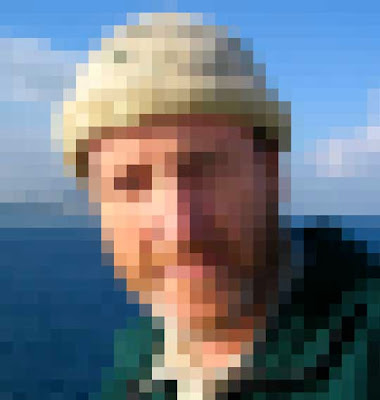It seems like a very modern notion until you see how the Romans did the same thing a couple thousand years ago.
Wednesday, June 3, 2009
Ancient Pixel Knowledge
Take a photo of a face and break down to about 30 pixels across, and you’ve got a low-res deconstruction in the manner of Chuck Close.

It seems like a very modern notion until you see how the Romans did the same thing a couple thousand years ago.
 The mosaic artists in Tunisia created these faces according to the same kind of reductive thinking. They were mostly itinerant artists, carrying a huge batch of tile colors.
The mosaic artists in Tunisia created these faces according to the same kind of reductive thinking. They were mostly itinerant artists, carrying a huge batch of tile colors.
 They would cover a whole floor with scenes of mermaids and animals and gods, working pixel by pixel.
They would cover a whole floor with scenes of mermaids and animals and gods, working pixel by pixel.
It seems like a very modern notion until you see how the Romans did the same thing a couple thousand years ago.
Subscribe to:
Post Comments (Atom)







13 comments:
James,
Another thought-provoking post. The mosaics and the pixel photo benefit from squinting. Am I correct in thinking the top photo is you, with the monkey off your back?
We had to do a similar exercise in art school (alas, some years before the graphical computer!). I believe we had to place a grid over a magazine photo and similarly grid a piece of illustration board, then paint each square on the illustration board whichever solid color was predominant in the magazine photo. With various coarsenesses.
I can't imagine what that was supposed to teach us in 1978, however.
My wife is a ceramic artist and she makes mosaics from digitized images.
Megumi Naitoh
Does anyone know how to make a photo 30 pixels across? This would make a great high-school painting project.
Thanks,
Harold
In the early 90s I saw an article in the good old National Geographic about cocaine. There was a closeup of a police bulletin board showing photos of various smugglers who got caught with bundles taped to their bodies, with their faces pixelated. For some reason the pixels were interesting, even though at the time computers weren't.
Anyway, I did a few of those images for practice, then tried a few of my own on non-pixelated photos. I found that each pixel contains the mix of all the colors in the pixel. It was interesting, but after 6-7 paintings it was time to try something else.
Fun while it lasted, though, and they all sold!
What I find interesting is the variable way in which the "pixels" could be arranged with mosaic tiles whereas our primitive computers are stuck with a fairly limiting X - Y axis arrangement of pixels all arranged perpendicular to these axes. The mosaic artists were seemingly combining some a simple vector- as well as raster-based approach, giving them far more flexibility than a simple grid pattern would allow. I noticed how smooth the jaw lines were in the mosaic tiles and how the computer version leaves a lot to be desired.
I believe Coro Kaufman, who works at Massive Black, has done some nice "pixel" style oil portraits. Its really interesting when such an old technology, ie. "low resolution" color blocking producing a readable image, gets recycled and becomes advanced technology in our eyes. Kinda makes wonder about the basis of our "advanced" technology, and what other knowledge the ancients had that has since been lost/transformed. I find it extremely interesting and amusing how what used to be magical formulae, holy ratios, transmutational admixtures, how now become science and technology...and that science and technology are now reaching a point again where it's beginning to seem like magic again.
Thanks for this insight. When we are in Greece and Italy later this year I'll look for this.
I like the ancient mosaics because they have such a lower color count; each color is a different type of rock. I also like how practical the art is; it's usually the floor in some villa (before we hang it on a museum wall in modern times).
Years ago (at the dawn of the PC age) I saw an article I think in Scientific American, where someone had studied the absolute minimum number of pixels necessary for a person to recognize a human individual. I seem to remember they used the famous painting of George Washington, and one of the Mona Lisa. Incredibly, I think they found it possible to make recognizable portraits with something like 16 x 16 pixel grids.
Maybe we'll figure out how to make triangular pixels too! Those ancients were ahead of us, darnit!
Fascinating. Certain painters advocate an approach similar to this. Charles Hawthorne ("Hawthorne On Painting") in particular often emphasized that painting is a matter of placing daubs of color next to each other, and that other considerations (like drawing & modeling) tend to resolve themselves if the basic juxtaposition of color daubs is correct. That theory seems borne out by pixelated photos like the one above.
I still marvel at how we can recognise a person by their pixels.
To Harold, if you have a picture editing program, this effect can be achieved by resizing (reducing) your photo and then blowing it back up again. Even Paint should be capable of doing this through the stretch/distort option. (I'm guessing on the name, my version is in German) Good luck and have fun with your students!
Post a Comment